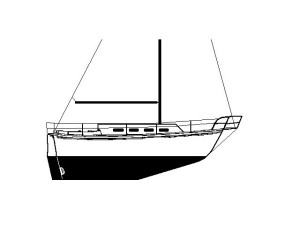Pilot Cutter
32' x 5 Tons, Full Keel & Cutaway Forefoot
9-Ft. Dia. BUORD Parachute
Force 8 Conditions
File S/M-7, obtained from Dennis Lueck, Pensacola FL. - Vessel name Wind Song, hailing port Pensacola, Pilot Cutter designed by Frank Parrish, LOA 32' x LWL 20' x Beam 9' x Draft 5' x 5 Tons - Full keel & cutaway forefoot - Sea anchor: 9-ft. Diameter BUORD on 300' x 1/2" nylon three strand rode with 1/2" galvanized swivel - No trip line - Deployed during passage of frontal trough in shallow water (6 fathoms) off the Florida coast with winds of 35-40 knots and choppy seas of 8 feet - Vessel's bow yawed as much as 90° off to each side in the gusts.
Wind Song, a brand new Pilot Cutter, was being sailed from Tampa to her home port of Pensacola when a weather front arrived. The crew decided to play it safe with the new boat and deployed a 9-ft. BUORD, in 6 fathoms of water, about 30 miles offshore and due west of Bayport, Florida. The parachute did not do a satisfactory job of pulling the bow of Wind Song into the seas. The boat would get beam-on to the seas in the gusts. Notwithstanding, the motion was still much better than lying a-hull. Here is a transcript of her owner's feedback:
After rounding up to deploy the sea anchor, we forgot to return the rudder amidships, so it was hard to port all night (and not discovered till morning). As a result (I believe) the boat would get beam-on to the seas in the gusts and then roll. As it was, the motion was still much better than lying a-hull....
The rode did hit the bobstay and whisker stays quite often but did not chafe. We tried the "Pardey Bridle," but the snatch block stayed against the hull and we were afraid of chafe....
Incidentally, the boat was brand new and we were bringing it home. It had been dead calm and we were motoring north about 50 miles north of St. Petersburg when the front came through. As we had no sailing experience with this boat and it was night, we elected to heave-to with the sea anchor. Today, with similar conditions, we would sail the boat reefed down.
Why didn't the sea anchor pull the bow of this yacht into the seas? The problem of side-to-side yaw is related to the shape of the hull and keel, the position of the CLR (center of lateral resistance), the type of rig and the position of the CE (center of effort). It is most aggravated when the CLR is well aft and the CE well forward. This gives the wind a larger lever to push the bow off.
Boat design has always been the art of compromise and naval architects have seen the cutaway forefoot as something that enhances the course-keeping qualities of a yacht and lessens her tendency to broach in strong following seas. As long as such a yacht is sailing forward her underwater profile resembles an arrow in flight. The trade off, of course, is her behavior at anchor.
More than likely, however, Wind Song just didn't have enough wind. Seraffyn has unevenness associated with her underwater shape as well, but recall the Pardeys' words in File S/M-3, "If there was a lot of wind, the para-anchor held her pretty close to head to wind."
Love the Drag Device Database? Help us to keep it free for all mariners by making a tiny donation to cover our server and maintenance costs. Thank You!
